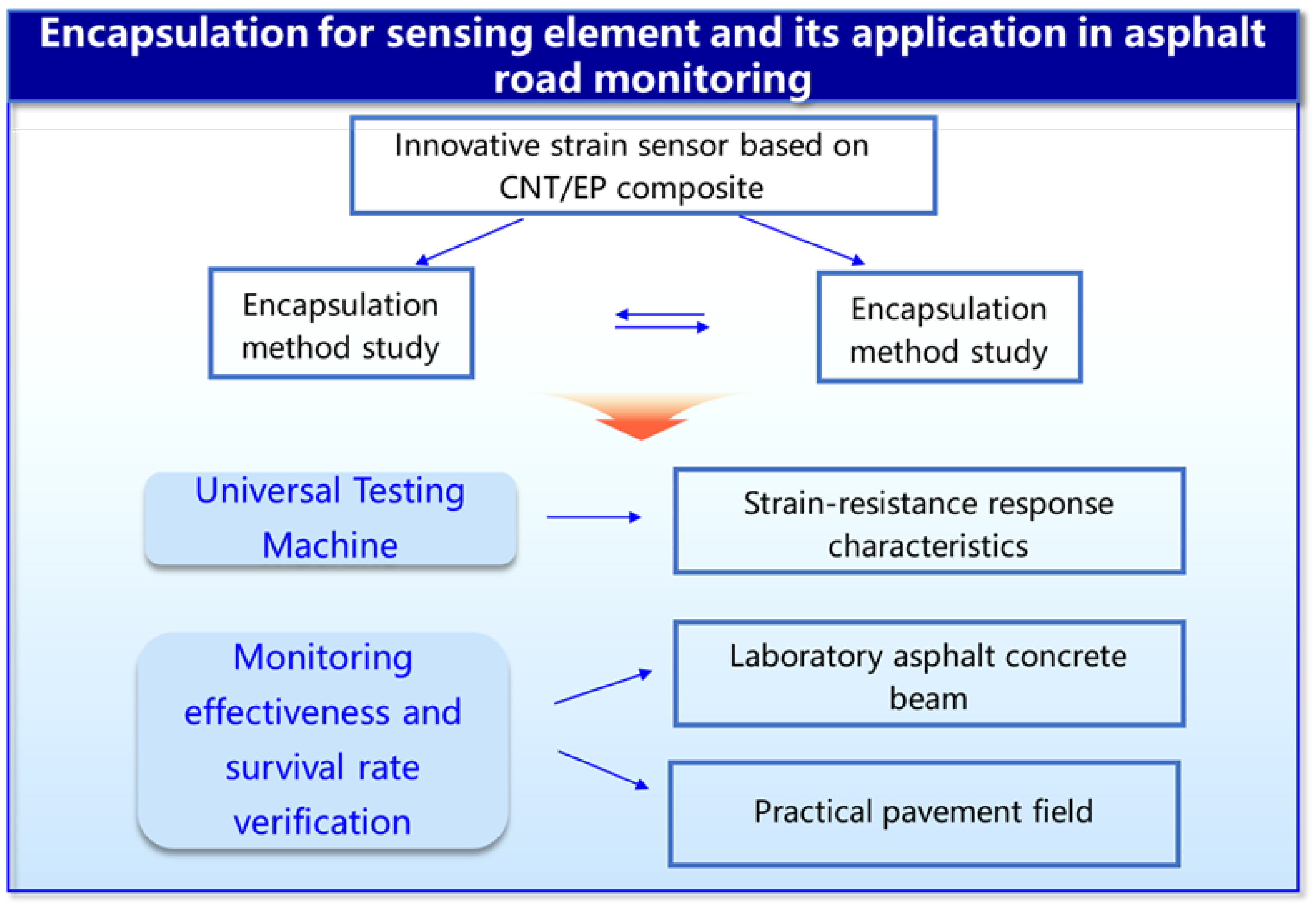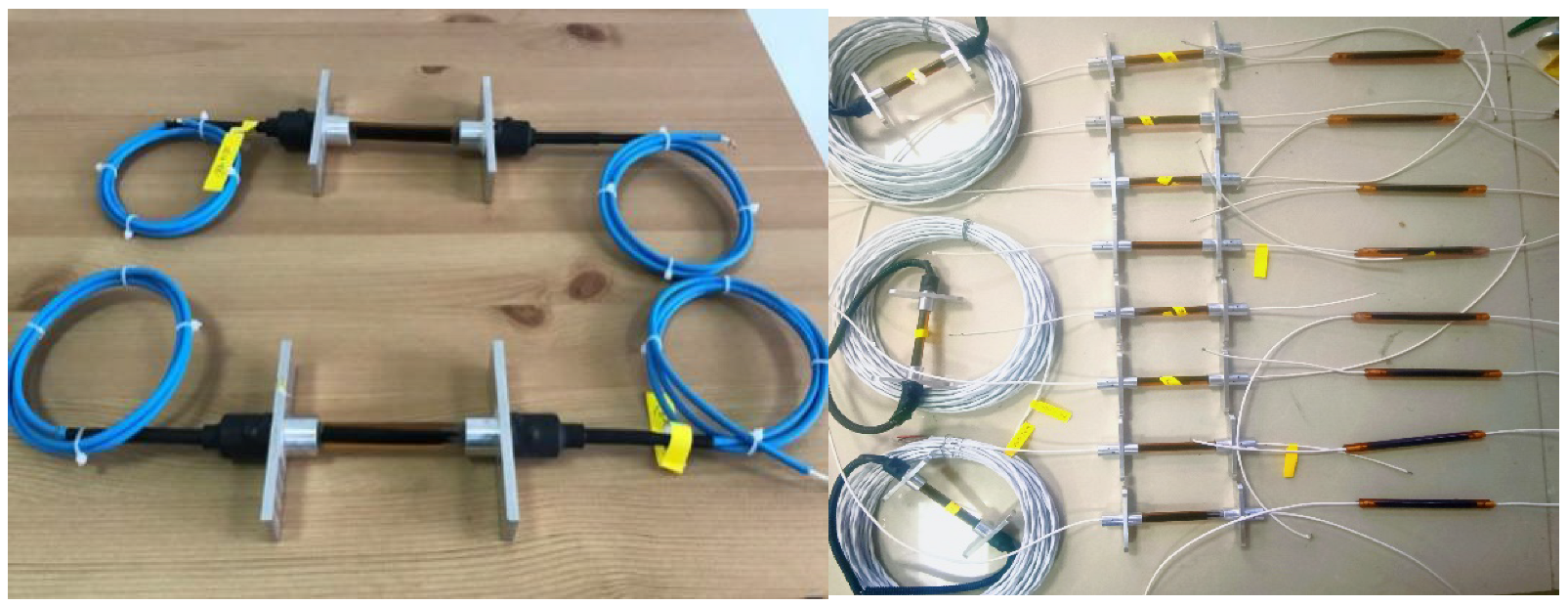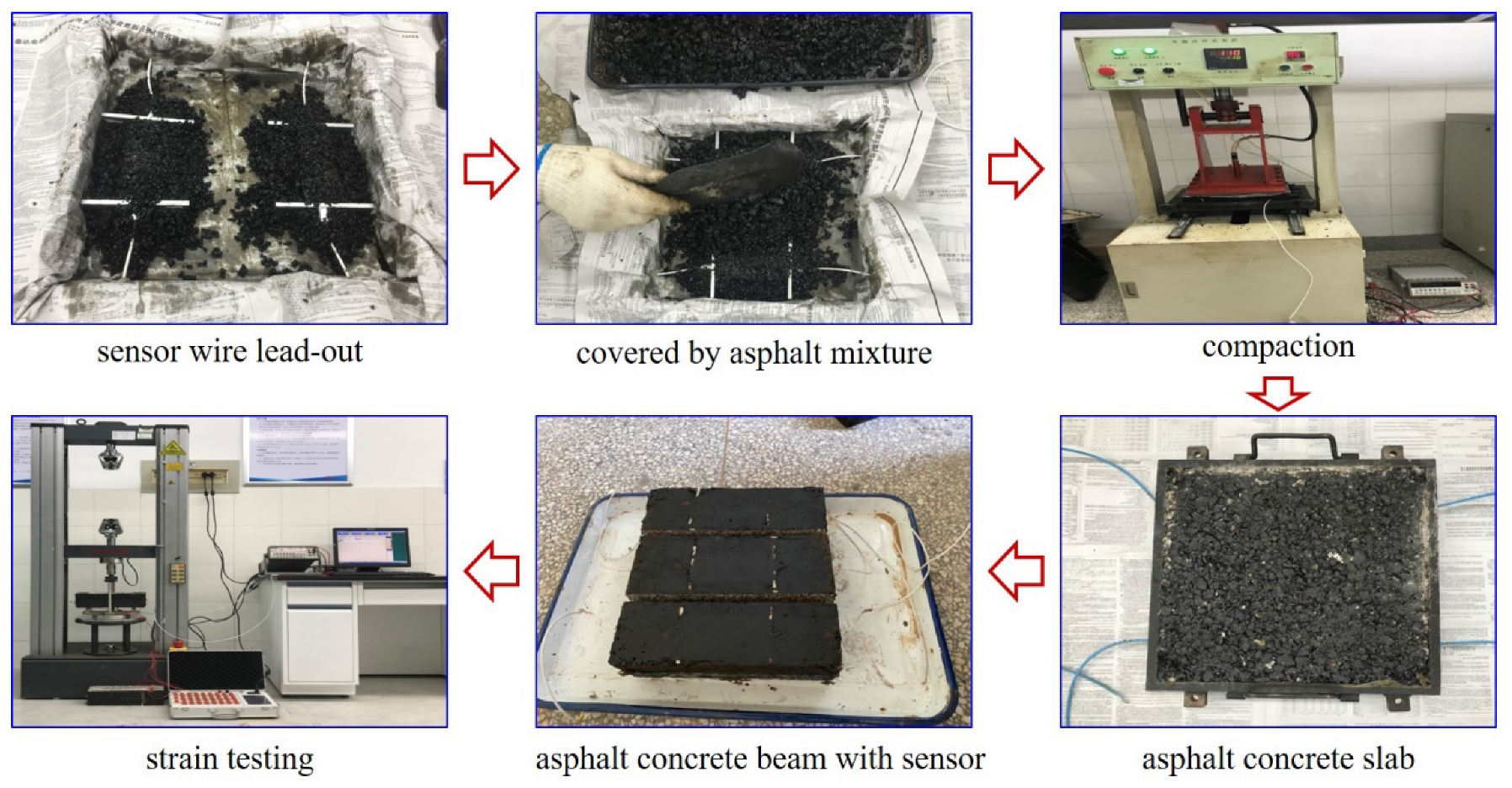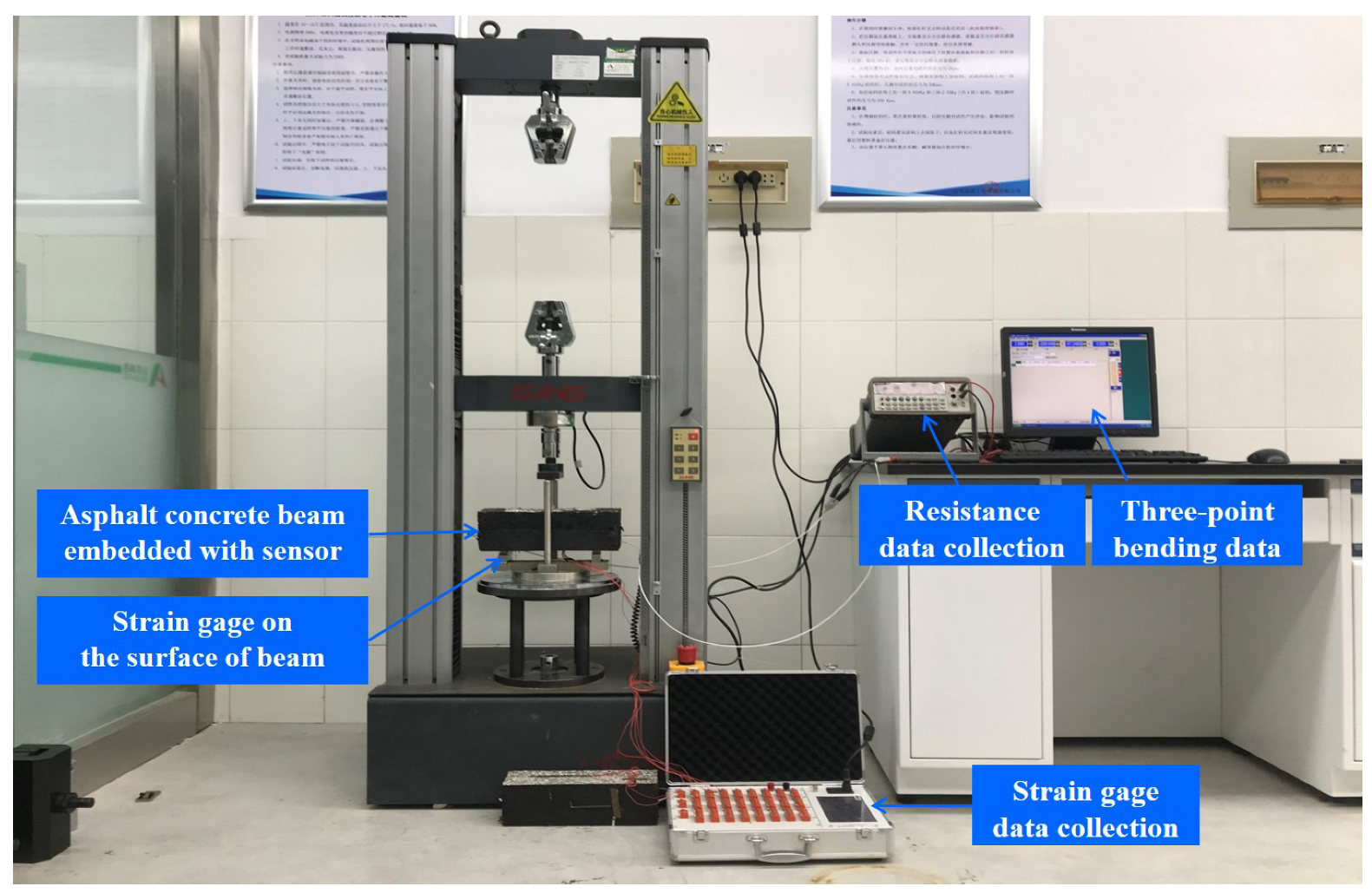Encapsulation for Sensing Element and Its Application in Asphalt Road Monitoring
Abstract
:1. Introduction
2. Preparation and Encapsulation of Smart Material-Based Strain Sensors
2.1. Preparation of Carbon Nanotube/Epoxy Resin (CNT/EP) Composites
2.2. Encapsulating MWCNT/EP Composite Rod by Epoxy for Manufacturing Strain Sensing Element
3. Strain–Resistance Response Characteristics of the Self-Developed I-Shaped Sensor
3.1. Embedding Process of Sensor in Asphalt Concrete Slab
3.2. Strain Monitoring Effectiveness of the Sensor in Asphalt Concrete
3.3. Application of Self-Developed Sensor in Practical Pavement Interlayer Strain Monitoring
4. Conclusions
- The self-developed embedded strain sensor can detect the strain changes in the asphalt pavement structure. When it is subjected to an external load, the conductive path is changed accordingly in conductive MWCNT/EP composite material, causing changes in the resistance of the sensor.
- The strain monitoring effectiveness test showed that the sensor has a high sensitivity to strain, and the resistance value of the sensor is linearly related to the changes in the external strain.
- By comparing with the commercial strain sensor, the self-developed embedded strain sensor has the advantage of deformation coordination and consistency with the road structure because of the encapsulating materials and packaging techniques studied in this paper, which can help to improve the monitoring accuracy.
- The embedding of the sensor in asphalt concrete slab and its application in practical pavement both showed that the sensor could effectively survive after being subjected to high temperature and heavy pressure during asphalt pavement compaction, which verified the feasibility of a self-developed sensor in asphalt pavement strain monitoring.
Author Contributions
Funding
Institutional Review Board Statement
Informed Consent Statement
Data Availability Statement
Conflicts of Interest
References
- China Highway Network Website. Available online: http://www.chinahighway.com/ (accessed on 12 November 2022).
- Di Graziano, A.; Marchetta, V.; Cafiso, S. Structural health monitoring of asphalt pavements using smart sensor networks: A comprehensive review. J. Traffic Transp. Eng. 2020, 7, 639–651. [Google Scholar] [CrossRef]
- Corticelli, R.; Pazzini, M.; Mazzoli, C.; Lantieri, C.; Ferrante, A.; Vignali, V. Urban Regeneration and Soft Mobility: The Case Study of the Rimini Canal Port in Italy. Sustainability 2022, 14, 14529. [Google Scholar] [CrossRef]
- Tiboni, M.; Rossetti, S.; Vetturi, D.; Torrisi, V.; Botticini, F.; Schaefer, M.D. Urban policies and planning approaches for a safer and climate friendlier mobility in cities: Strategies, initiatives and some analysis. Sustainability 2021, 13, 1778. [Google Scholar] [CrossRef]
- Shtayat, A.; Moridpour, S.; Best, B.; Shroff, A.; Raol, D. A review of monitoring systems of pavement condition in paved and unpaved roads. J. Traffic Transp. Eng. 2020, 7, 629–638. [Google Scholar] [CrossRef]
- Du, Z.; Yuan, J.; Xiao, F.; Hettiarachchi, C. Application of image technology on pavement distress detection: A review. Measurement 2021, 184, 109900. [Google Scholar] [CrossRef]
- Mataei, B.; Nejad, F.M.; Zakeri, H. An improved multiresolution technique for pavement texture image evaluating. Multimed. Tools Appl. 2023, 82, 3007–3031. [Google Scholar] [CrossRef]
- Salour, F.; Erlingsson, S. Investigation of a pavement structural behaviour during spring thaw using falling weight deflectometer. Road Mater. Pavement Des. 2013, 14, 141–158. [Google Scholar] [CrossRef]
- Jung, F.W.; Stolle, D.F. Nondestructive Testing with Falling Weight Deflectometer on Whole and Broken Asphalt Concrete Pavements. Transp. Res. Rec. 1992, 1377, 183–192. [Google Scholar]
- Salour, F.; Erlingsson, S. Impact of Groundwater Level on the Mechanical Response of a Flexible Pavement Structure: A Case Study at the Torpsbruk Test Section along County Road 126 Using Falling Weight Deflectometer; VTI: Sydney, Australia, 2014. [Google Scholar]
- Li, W. A theoretical analysis of the evolution of traffic and transportation structure development. Water Transp. Manag. 2000, 7, 2–7. [Google Scholar]
- Fang, L.; Guo, B.; Zheng, Y.; Zhang, X. Research on intelligent monitoring technology for asphalt pavement construction. China Meas. Test. 2022, 47, 122–125. [Google Scholar]
- Yang, Y.; Wang, L.; Wei, J.; Ma, S. Data collection and analysis of dynamic response of typical pavement structures under heavy load. Road Traffic Technol. 2010, 27, 11–16. [Google Scholar]
- Zeng, J.; Xiao, C.; Li, B.; Xu, T. Study on the effect of temperature on the dynamic response of asphalt pavement under FWD loading. Highw. Eng. 2015, 40, 107–111, 161. [Google Scholar]
- Mustafa, S.; Sekiya, H.; Maeda, I.; Takaba, S.; Hamajima, A. Identification of external load information using distributed optical fiber sensors embedded in an existing road pavement. Opt. Fiber Technol. 2021, 67, 102705. [Google Scholar] [CrossRef]
- Mustafa, S.; Sekiya, H.; Morichika, S.; Maeda, I.; Takaba, S.; Hamajima, A. Monitoring internal strains in asphalt pavements under static loads using embedded distributed optical fibers. Opt. Fiber Technol. 2022, 68, 102829. [Google Scholar] [CrossRef]
- Xiang, P.; Wang, H. Optical fibre-based sensors for distributed strain monitoring of asphalt pavements. Int. J. Pavement Eng. 2016, 19, 842–850. [Google Scholar] [CrossRef]
- Li, Q.; Cary, C.; Combs, S.; Garg, N. Evaluation of asphalt concrete layer response using asphalt strain gauges and fiber optic strain gauges. In Proceedings of the International Conference on Transportation and Development, Houston, TX, USA, 26–29 June 2016; pp. 42–53. [Google Scholar]
- Han, M.; Muhammad, Y.; Wei, Y.; Zhu, Z.; Huang, J.; Li, J. A review on the development and application of graphene based materials for the fabrication of modified asphalt and cement. Constr. Build. Mater. 2021, 285, 122885. [Google Scholar] [CrossRef]
- Liu, Y. Development and Research of Rubber Encapsulated FBG Asphalt Pavement Vertical Strain Sensor; Harbin Institute of Technology: Harbin, China, 2008. [Google Scholar]
- Wu, B.; Lin, Z.; Zeng, Y.; Lin, Z.; Lu, H. Experimental study on the temperature sensitivity coefficient of fiber-encapsulated long-scale strain sensors. Adv. Laser Optoelectron. 2022, 59, 142–149. [Google Scholar]
- Liang, L.; Liu, D.; Li, P. Research on carbon fiber composite encapsulated fiber optic sensors. J. Wuhan Univ. Technol. 2008, 30, 55–57. [Google Scholar]
- Rana, S.; Subramani, P.; Fangueiro, R.; Correia, A.G. A review on smart self-sensing composite materials for civil engineering applications. AIMS Mater. Sci. 2016, 3, 357–379. [Google Scholar] [CrossRef]
- Li, P.; Jiang, W.; Lu, R.; Yuan, D.; Shan, J.; Xiao, J. Design and durability of PZT/PVDF composites based on pavement perception. Constr. Build. Mater. 2022, 323, 126621. [Google Scholar] [CrossRef]
- Hou, S.; Lei, J.; Ou, J. Vehicle load monitoring for asphalt concrete pavement based on smart aggregates. J. Vib. Shock 2014, 33, 42–47. [Google Scholar]
- Zhao, Q.; Wang, L.; Zhao, K.; Yang, H. Development of a Novel Piezoelectric Sensing System for Pavement Dynamic Load Identification. Sensors 2019, 19, 4668. [Google Scholar] [CrossRef] [PubMed]
- Wang, Q. Research on the Electrical Conductivity and Mechanosensitivity of Carbon Fiber Epoxy Resin Composites; Chongqing University: Chongqing, China, 2006. [Google Scholar]
- Xin, X.; Liang, M.; Yao, Z.; Su, L.; Zhang, J.; Li, P.; Sun, C.; Jiang, H. Self-sensing behavior and mechanical properties of carbon nanotubes/epoxy resin composite for asphalt pavement strain monitoring. Constr. Build. Mater. 2020, 257, 119404. [Google Scholar] [CrossRef]
- Xin, X.; Yu, R.; Su, L.; Qiu, Z.; Yang, C.; Liang, M.; Ji, P.; Zhong, G.; Yao, Z. Dynamic Mechanical and Chemorheology Analysis for the Blended Epoxy System with Polyurethane Modified Resin. J. Renew. Mater. 2022, 10, 1081. [Google Scholar] [CrossRef]
- Xin, X.; Qiu, Z.; Luan, X.; Ding, X.; Liang, M.; Yao, Z.; Li, Y. Novel conductive polymer composites for asphalt pavement structure in situ strain monitoring: Influence of CB/CNT and GNP/CNT nano/micro hybrid fillers on strain sensing behavior. IEEE Sens. J. 2022, 10, 3945–3956. [Google Scholar] [CrossRef]
- Xin, X.; Luan, X.; Su, L.; Ma, C.; Liang, M.; Ding, X.; Yao, Z. The innovative self-sensing strain sensor for asphalt pavement structure: Substitutability and synergy effects of graphene platelets with carbon nanotubes in epoxy composites. Front. Mater. 2022, 9, 824364. [Google Scholar] [CrossRef]
- Guo, L.; Chen, X.; Yu, J.; Tang, Y.; Liu, R.; Rogers, R.; Leidy, J.; Claros, G. Pavement deflection vehicle weighing method with embedded piezoelectric sensor. SPIE Proc. 2005, 5758, 471–478. [Google Scholar]
- Tan, Z.; Li, H.; Xu, X.; Wu, C.; Liu, F. Study on the arrangement scheme of asphalt pavement mechanical response monitoring system. J. Wuhan Univ. Technol. 2017, 41, 528–532. [Google Scholar]









Disclaimer/Publisher’s Note: The statements, opinions and data contained in all publications are solely those of the individual author(s) and contributor(s) and not of MDPI and/or the editor(s). MDPI and/or the editor(s) disclaim responsibility for any injury to people or property resulting from any ideas, methods, instructions or products referred to in the content. |
© 2023 by the authors. Licensee MDPI, Basel, Switzerland. This article is an open access article distributed under the terms and conditions of the Creative Commons Attribution (CC BY) license (https://creativecommons.org/licenses/by/4.0/).
Share and Cite
Ma, C.; Xin, X.; Zhang, N.; Wang, J.; Wang, C.; Liang, M.; Zhang, Y.; Yao, Z. Encapsulation for Sensing Element and Its Application in Asphalt Road Monitoring. Coatings 2023, 13, 390. https://doi.org/10.3390/coatings13020390
Ma C, Xin X, Zhang N, Wang J, Wang C, Liang M, Zhang Y, Yao Z. Encapsulation for Sensing Element and Its Application in Asphalt Road Monitoring. Coatings. 2023; 13(2):390. https://doi.org/10.3390/coatings13020390
Chicago/Turabian StyleMa, Chuanyi, Xue Xin, Ning Zhang, Jianjiang Wang, Chuan Wang, Ming Liang, Yunfeng Zhang, and Zhanyong Yao. 2023. "Encapsulation for Sensing Element and Its Application in Asphalt Road Monitoring" Coatings 13, no. 2: 390. https://doi.org/10.3390/coatings13020390




